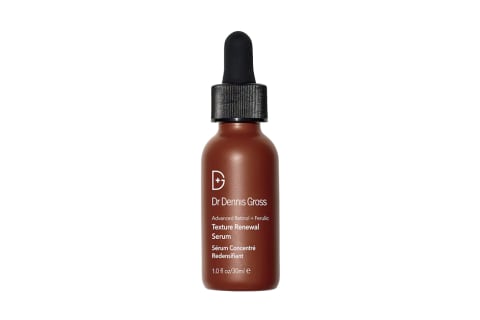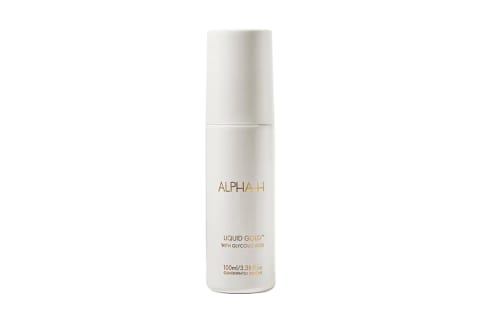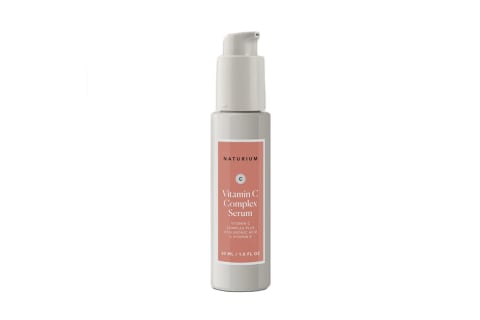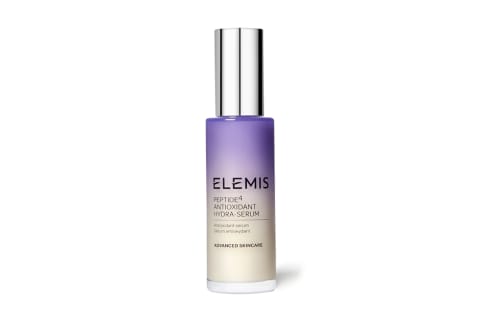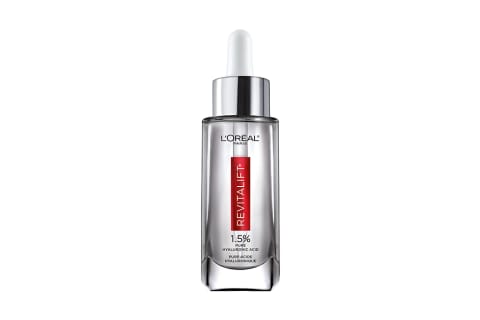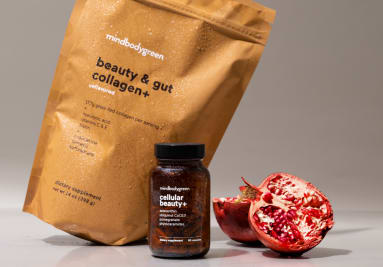Wrinkles By Age Group: Types Of Fine Lines + Derm-Approved Tips


Perhaps a shocking opinion by today's standards, but I think wrinkles are so damn sexy. (I didn't always feel this way, but as I've earned a new decade, I've really started to embrace their appeal.) There is something so enticing about a face that looks lived in, no? I want to see people with lines that show they've been laughing, smiling, feeling their emotions, and you know, living.
And as a diligent skin care professional and devotee, I care for my skin as best I can. I want it to look luminescent and glowing now, and for many years to come. And (stay with me on this one) using skin-enhancing products and embracing how your skin ages aren't competing concepts. You can appreciate the beautiful signs of maturing skin—and at the same time, use topicals that keep your complexion plump, firm, and lively.
And, here, I'm going to walk you through how to do exactly that.
Types of wrinkles.
There are many subcategories that fall under the umbrella of fine lines and wrinkles. If you are interested in caring for your skin and its wrinkles, then it's important to understand what types there are, how they form, and what makes them unique.
It's a big topic, so much so that an entire article could be written about it. Luckily, we already did that: Read up in our guide to the types of wrinkles. Wrinkles can actually be classified in two different ways: How they formed and where they appear. Let's quickly outline both:
Types of wrinkles based on how they are formed:
- Expression: Wrinkles formed by normal facial movements and expression.
- Elastotic: Wrinkles formed by the decrease in elastin
- Gravitational: Wrinkles formed by the effects of gravity.
- Compression: Wrinkles formed from the pressure put on your face when you sleep.
- Atrophic: Wrinkles formed from the normal breakdown of skin structural components, like collagen.
Types of wrinkles based on placement:
- Crow's feet: An expression-based wrinkle that forms on the outer corners of the eye.
- Under-eye: Wrinkles that may happen under the eye and above the cheek on the orbital area.
- Smile lines: Also referred to as "laugh lines," or "marionette lines," these extend from the sides of your nose and curve around your mouth.
- Chest wrinkles: These are a mixture of compression and atrophic wrinkles that often happen because the skin is thin and more readily exposed to UV rays.
- Forehead lines: Forehead wrinkles are an expression-based wrinkle that can show up either as horizontal etches from raising your brows (called "surprise lines") or vertical lines from pushing your brow muscles together (also known as the "11s").
- Neck lines: Horizontal lines that form around your neck. Today, these are much more common and often called "tech neck."
Wrinkles by age group.
With the types of wrinkles in mind, we can better understand the sort of changes you might see in your skin with each decade. Of course, I must also present a very important caveat: How your skin ages is dependent on many factors that are unique to you—from lifestyle choices and skin care habits to genetics and more. In this article, I am speaking in broad terms (i.e., what many people generally experience), so take that into consideration: Your skin may not follow these exact patterns.
The best advice I can give you to help you on your journey is to find a skin care professional you trust who can guide you in your decisions. And ultimately, you are the person living in your skin, and there's little more powerful than self-knowledge. It's also very important to get to know your skin—what it reacts positively to and what it doesn't—so you'll be better equipped to nurture your complexion for many happy years.
Wrinkles in your 20s.
If you see fine lines in your 20s, the culprit is less likely aging and more to do with skin hydration (or lack thereof). Board-certified and holistic plastic surgeon Anthony Youn, M.D., explains that if you are in your 20s, fine lines on the forehead, under eyes, and in the nasolabial folds are usually the result of dry skin, rather than aging.
However, we'd be remiss not to note that this is the decade your collagen starts to naturally decline, at a rate of about 1% a year1. (However, the exact age that this process starts is different for everyone; genetics and lifestyle factors play a large role in this. "Our bodies always balance collagen production and degradation," explains board-certified dermatologist Gary Goldenberg, M.D. "When we are young, our bodies produce more collagen than we break down. That balance tips the wrong way with age since tissue regeneration decreases."
Wrinkles in your 30s.
In this decade, you'll start to notice your skin simply doesn't bounce back like it used to. And thus, more permanent wrinkle formation has begun.
It's important to note that everyone's skin wrinkles and folds when moving the face—no matter the age. These are referred to as dynamic lines. "Examples include the frown lines (often referred to as the 11s) between the brows, forehead wrinkles, crow's feet, lip lines (when you drink from a straw or purse your lips), and smile lines on the mid-cheek," says board-certified dermatologist Cynthia Bailey, M.D., founder of Dr. Bailey Skin Care. "Over time, these lines will deepen and etch into the skin, similar to the way folding paper will leave a crease."
And what we see in the 30s is that these lines slowly start to take a more permanent position, due to the collagen and elastin decline. Additionally, these are exacerbated by any less-than-stellar lifestyle habits we may have had in our younger years such as sunbathing and lack of sleep.
That's why many professionals consider the 30s a critical time in skin care: If you haven't adopted a smart, healthy aging routine, the time is now. For most, that means moving beyond just hydrating lotions and adding in target actives. "Hydrating the skin can reduce the visibility of wrinkles temporarily, but it isn't a solution," Youn says. "Make sure to [consider options like] a retinoid, vitamin C, and exfoliation for real skin rejuvenation."
Wrinkles in your 40s.
"In your 40s, signs of sun exposure may show up more prominently with decreased skin elasticity," board-certified dermatologist Keira Barr, M.D., previously told us. "Hormones may be shifting, which means more dryness, irritation, and sensitivities."
Because of these changes, you'll likely see the formation of static wrinkles. Remember those dynamic wrinkles that slowly start to deepen in your 30s? Well by your 40s, they'll become static wrinkles. This means that they are present even without moving your face.
However, the areas in which you develop these will be largely influenced by your face shape, talking patterns, and genetics. For example, some people are more prone to "the 11s" because they furrow their brow, while others develop "marionette lines" because they often hold tension in the lower half of their faces.
Wrinkles in your 50s & beyond.
Due to hormonal changes in this decade, most people experience a significant drop in collagen. For example, those who experience menopause see a 30% drop in collagen production2 in a few years, which then levels off to about a 2% drop in production every year thereafter. Similar to collagen, hyaluronic acid, squalene, elastin, and ceramide production also continue to decline. These changes are natural, normal, and in a lot of ways, unavoidable.
Knowing these decline more rapidly at this stage of life, we can better understand the changes that we might experience in our skin. Half the battle is anticipating and understanding what's happening in our bodies, then we can make informed decisions to care for it more thoughtfully.
Sagging, especially in the lower half of the face, is common due to loss of firmness. Increased dryness and reduced moisture retention happen from the drop in hyaluronic acid and squalane. (Dryness can then worsen the appearance of fine lines.) Increased sensitivities come from ceramide reduction, as ceramides play an important role in your skin barrier function.
Contributing factors to wrinkles.
A lot of factors influence how your skin looks and feels, so there's no one single "cause" of fine lines. Instead, it's a mix of factors that are both outside and within your control. For more information on the many influences of aging skin, check out our guide.
- Genetics. Your genetics determines much about your overall health, skin included.
- Smoking. I assume you know that smoking can trigger wrinkles by now.
- Sun exposure. UV rays are the most common cause of wrinkles3 and other signs of aging.
- Daily habits. Sleeping positions and regular, repetitive motions can slowly lead to wrinkle formation.
- Lifestyle considerations. Lack of exercise and poor diet habits can exacerbate fine line formation.
- Stress. "Stress can't be emphasized enough. Stress hormones like cortisol break down our collagen and elastin and interfere with rejuvenation," says Barr. "Everyone has such a unique relationship with stress, and learning how to recognize the stressors in our lives and acquiring the skills and tools to navigate and manage those stresses is the most potent 'wrinkle reducer' I can offer my clients."
Topical ingredients to look for to help ease wrinkles.
There are so many products at your disposal that help with the appearance of fine lines, from hydrating numbers to potent actives that encourage cell renewal:
- Retinol: Often called the gold standard for aging skin, retinols spur cell turnover, fade discoloration, and encourage collagen production. For a sensitive and pregnancy-safe alternative, use bakuchiol4.
- Alpha-hydroxy acids. Alpha-hydroxy acids5 are chemical exfoliants, so they are used to slough off dead skin cells, brighten, even tone, and reverse signs of aging. But because of their hydrophilic qualities, they are also moisturizing as well.
- Vitamin C & E. Vitamin C and E are synergistic antioxidants, meaning they work together to support each other's functions in the body. Vitamin C plays a vital role in the collagen synthesis process, and vitamin E helps stabilize it. As they are both antioxidants, they also help combat free radicals.
- Peptides. The research on peptides is still growing, but we believe it's promising. When used topically, they act as messengers in the skin. Like in the case of Matrixyl, or palmitoyl pentapeptide-3, it tells the fibroblasts to stimulate collagen production6. Just know that until more research is done, we should be cautious about what results we are expecting.
Beauty supplements.
In addition to topicals to support your skin function, you can invest in smart supplements to provide your skin with nutrients that can encourage collagen production, hydration, tone improvement, and overall appearance.*
Collagen peptides are a fantastic place to start for adults at any stage of their journey. Collagen supplements can help promote your body's natural production by supporting the cells' fibroblasts; studies show that when taken regularly, people may see a reduction in fine lines and improved hydration7.* (Check out our favorite collagen supplements here.)
Antioxidant support is essential, too. Antioxidant supplements are dietary products containing nutrient, phytonutrient, or bioactive antioxidants, or substances that neutralize free radicals.* There are also many different types of antioxidants to choose from that all come with their own unique benefits: We love ubiquinol, vitamin C, vitamin E, astaxanthin, polyphenols, turmeric, resveratrol, and omega-3 fatty acids for skin support.*
Finally, look for nutrients that can support moisture retention and skin hydration, such as phytoceramides, hyaluronic acid, and omega-3 fatty acids.*
Want more information on supplements? Check out our guides to healthy aging supplements and beauty supplements.
The takeaway.
Getting a glowing, smoothing, happy complexion can happen at any age and any stage of life. The most important thing is that you're happy in the skin you're in. Want more healthy aging tips? Here are 24 tips for a youthful glow.

Alexandra Engler is the beauty director at mindbodygreen and host of the beauty podcast Clean Beauty School. Previously, she's held beauty roles at Harper's Bazaar, Marie Claire, SELF, and Cosmopolitan; her byline has appeared in Esquire, Sports Illustrated, and Allure.com. In her current role, she covers all the latest trends in the clean and natural beauty space, as well as lifestyle topics, such as travel. She received her journalism degree from Marquette University, graduating first in the department. She lives in Brooklyn, New York.
7 Sources
- https://www.ncbi.nlm.nih.gov/pmc/articles/PMC3583892/
- https://www.ncbi.nlm.nih.gov/pmc/articles/PMC2685269/
- https://www.ncbi.nlm.nih.gov/pmc/articles/PMC4292080/
- https://pubmed.ncbi.nlm.nih.gov/29947134/
- https://www.ncbi.nlm.nih.gov/pmc/articles/PMC6017965/
- https://www.sciencedirect.com/topics/chemistry/pentapeptide
- https://jddonline.com/articles/oral-collagen-supplementation-a-systematic-review-of-dermatological-applications-S1545961619P0009X/
